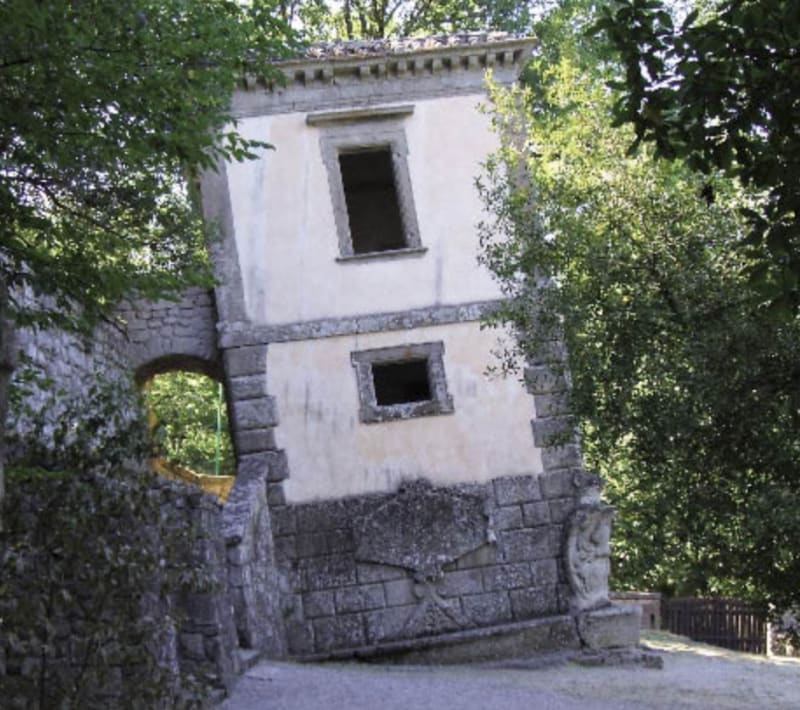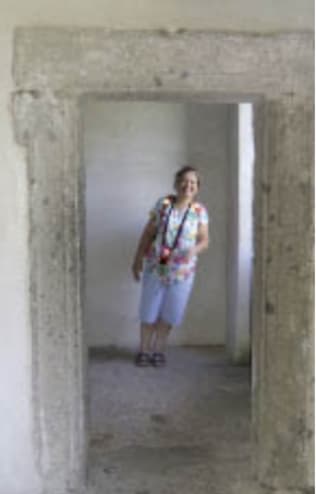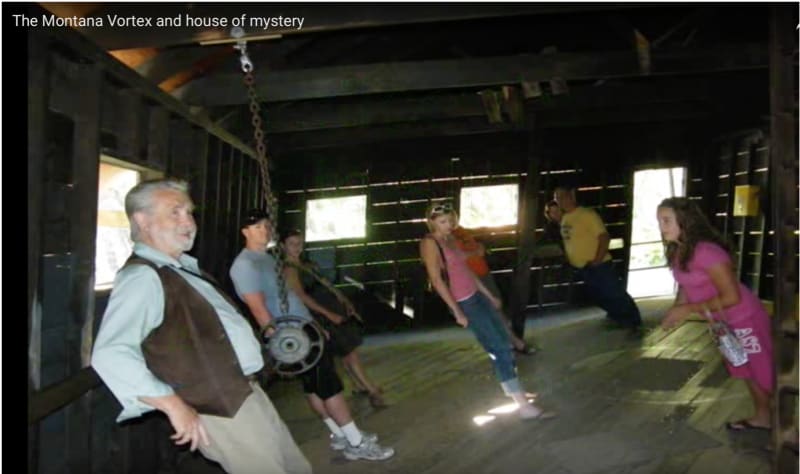Listing buildings

The Tower in Pisa leans by accident. There have however been a few houses built deliberately at angles: as though the entire structure had been designed with vertical walls and flat floors, and had then been tipped over.
The Sacred Grove at Bomarzo near Viterbo in Italy was laid out in the 1550s by Pier Francesco Orsini as a memorial to his wife Giulia. Orsini is thought to have been advised by the antiquarian and architect Pirro Ligorio. The Grove has none of the parterres, fountains or terraces of other Renaissance gardens: instead the visitor comes upon a series of monstrous statues scattered randomly throughout a wooded valley. Up until the 1970s the place was wild, mysterious and little visited. Since then it has been neatened up with paths and fences, and has become extremely popular. Erected on a large sloping-topped boulder, the Casa Pendente at Bomarzo is a little two-storey house in classical style, built at an angle of 10 degrees off the vertical.
From the outside one sees the tilt. When one goes inside however a gradual change in perception occurs. One first tries to stand ‘upright’ in relation to the walls and floor: in fact, one is leaning at an angle. One seems to be pushed by a horizontal force that threatens one’s balance. In time one assumes a truly vertical (but apparently leaning) posture and becomes comfortable with the fact that this is inconsistent with the room’s architecture. The house seems to right itself. Now other visitors (who are also truly vertical) appear to be leaning beyond their centres of gravity.

Two American psychologists Herman Witkin and Solomon Asch studied these effects experimentally in the 1940s, with a rectangular ‘room’ in the form of a frame of luminous rods in a darkened space, that could be tilted to different angles. Experimental subjects inside this schematic room were asked to set a rod in what they believed was a vertical position. Different individuals experienced the tilting effect to different extents.
The owners of the Mystery Spot attraction in the redwoods of Santa Cruz, California, claim that it is sited on a local gravitational anomaly where “the laws of physics and gravity are questioned.” “Some speculate that cones of metal were secretly brought here and buried in our earth as guidance systems for their spacecraft. Some think that it is in fact the spacecraft itself buried deep within the ground. Other theories include carbon dioxide permeating from the earth, a hole in the ozone layer, a magma vortex, the highest dielectric biocosmic radiation known anywhere in the world, and radiesthesia. Whatever the cause is, it remains a mystery.” In fact, the ‘anti-gravity house’ is built on a hill in such a way that the tilt, at an angle of about 20 degrees, is not so noticeable from the exterior. Inside, people stand leaning out beyond their feet, balls seem to roll up slopes, and water appears to flow uphill.
The Montana Vortex and House of Mystery near Glacier National Park is another place in America where the laws of nature are ‘skewed’. The place is reputedly sacred to Native Americans who bring offerings of tobacco and sweet grass. It is “By far one of the most paranormal places in the United States”. There are many mysteries here; but inside the House of Mystery, people again lean at dangerous angles, and a heavy chain suspended from the ceiling seems to hang well away from the vertical.

Did Orsini conceive the Casa Pendente at Bomarzo deliberately as a ‘house of mystery’? Little is known about the origins and design of the park, and the supposed involvement of Pirro Ligorio is conjectural. But Ligorio certainly devised surprising entertainments in other gardens, including the Fountain of the Owl at the Villa d’Este in Tivoli, where small mechanical birds sing until the owl turns towards them, when they all go quiet. Supposing Ligorio did work at Bomarzo: even if he and Orsini did not anticipate what the experience of entering the leaning house would be like, they must have soon found out.
Stefano Vezzani, ‘La casetta di Bomarzo’, CICAP, 25th January 2012, https://www.cicap.org/n/articolo.php?id=274651
Herman Witkin and Solomon Asch, ‘Studies in space orientation IV. Further experiments on perception of the upright in displaced visual fields’, *Journal of Experimental Psychology *38, 1948, pp.762-782